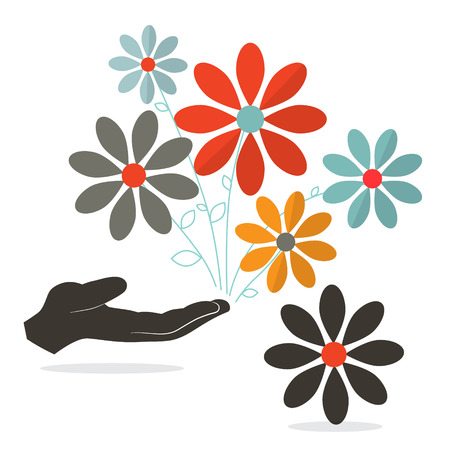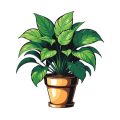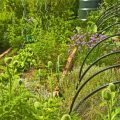1. Understanding Shade in Your Garden
Before selecting the perfect shade-loving annuals for your American garden, it’s important to understand the different types of shade and how they affect plant growth. Not all shade is created equal—some areas might receive filtered sunlight, while others stay dark most of the day. Knowing what kind of shade you’re working with will help you choose plants that thrive in those conditions.
Types of Shade
Here’s a quick guide to help you identify the type of shade in your garden:
| Type of Shade | Description | Common Locations |
|---|---|---|
| Full Shade | Receives less than 3 hours of direct sunlight per day; often deep shade most of the time. | North-facing walls, under dense trees, behind tall buildings |
| Partial Shade | Gets around 3–6 hours of morning or late afternoon sun, but shaded during hottest part of day. | East-facing gardens, spots protected by fences or structures |
| Dappled Shade | Filtered sunlight through tree leaves; light is scattered and gentle throughout the day. | Under open-branched trees like dogwoods or maples |
How to Evaluate Light Conditions in Your Yard
If you’re not sure what kind of shade you have, spend a day observing your garden at different times. Note which areas get direct sunlight and for how long. Use a notebook or even your phone to track light patterns from morning to evening. This simple observation can go a long way in helping you match the right plants to each spot.
Tips for Measuring Sunlight:
- Morning sun: Cooler and less intense—ideal for many partial shade plants.
- Afternoon sun: Stronger and hotter—many shade lovers prefer to avoid this.
- Use a light meter app: If you want more precision, try a smartphone app to measure sunlight exposure throughout the day.
By understanding the type of shade in your garden, you’ll be better prepared to choose annuals that will bring color and life even to your darkest corners.
2. Top Shade-Loving Annuals to Brighten Dark Corners
Even the shadiest spots in your garden can burst with color when you choose the right shade-loving annuals. These vibrant plants are perfect for patios, under trees, or along north-facing walls where sunlight is limited. Below is a list of some of the best easy-to-grow annual flowers that thrive in low-light American garden spaces.
Impatiens (Impatiens walleriana)
Impatiens are one of the most popular shade annuals in the U.S. Known for their bright blooms and compact growth habit, they’re ideal for flower beds, containers, and hanging baskets.
- Bloom Colors: Pink, red, orange, white, purple
- Light Needs: Partial to full shade
- Growing Zones: USDA zones 2–11 (as an annual)
Coleus (Plectranthus scutellarioides)
Coleus may not be grown for flowers, but its stunning foliage makes it a standout in any shady spot. With a huge variety of leaf shapes and colors, coleus brings texture and drama to darker areas.
- Foliage Colors: Green, burgundy, yellow, pink, red mixes
- Light Needs: Shade to part sun (varies by variety)
- Growing Zones: USDA zones 3–11 (as an annual)
Begonias (Begonia spp.)
Begonias are versatile bloomers that love shade and come in many forms—from wax begonias to tuberous types. They offer both attractive flowers and beautiful foliage.
- Bloom Colors: Red, pink, white, yellow, orange
- Light Needs: Partial shade to full shade
- Growing Zones: USDA zones 3–10 (as an annual)
Torenia (Torenia fournieri)
Torenia is also known as the wishbone flower and produces trumpet-shaped blooms that attract hummingbirds. It’s a great trailing plant for window boxes and containers.
- Bloom Colors: Purple, blue, pink, yellow with contrasting centers
- Light Needs: Partial to full shade
- Growing Zones: USDA zones 2–11 (as an annual)
Browallia (Browallia speciosa)
Browallia is sometimes called “amethyst flower” because of its rich violet-blue blossoms. It provides reliable color throughout summer in shady borders or containers.
- Bloom Colors: Blue, violet, white
- Light Needs: Dappled sun to full shade
- Growing Zones: USDA zones 2–10 (as an annual)
A Quick Comparison of Top Shade Annuals
| Name | Main Feature | Best Use | Light Requirement |
|---|---|---|---|
| Impatiens | Bountiful blooms in many colors | Beds, containers, borders | Partial to full shade |
| Coleus | Dramatic colorful foliage | Pots, mixed containers, edging | Shade to part sun |
| Begonias | Diverse flower & foliage options | Pots, hanging baskets, beds | Partial to full shade |
| Torenia | Tubular flowers attract pollinators | Window boxes, hanging baskets | Partial to full shade |
| Browallia | Lush blue-purple blossoms all summer long | Borders and containers in deep shade areas | Dappled to full shade |
If you’ve got a shady yard or garden spot that feels dull or lifeless, these vibrant annuals can bring it back to life without needing full sunlight. With just a little care and the right plant selection, even the darkest corners can become colorful highlights in your American garden.

3. Planting and Care Tips for Shady Spots
Growing annuals in shady areas of your garden can be just as rewarding as planting in full sun—you just need to know the right care methods. Heres a simple guide to help your shade-loving annuals thrive with healthy foliage and vibrant blooms.
Soil Preparation: Start with the Right Foundation
Shady spots often have compacted or damp soil. Loosening the top 6–8 inches of soil and mixing in organic matter like compost or peat moss helps improve drainage and provides nutrients.
Recommended Soil Amendments
| Amendment | Purpose | How to Use |
|---|---|---|
| Compost | Adds nutrients and improves texture | Mix 2–3 inches into the topsoil before planting |
| Peat Moss | Helps retain moisture in dry shade areas | Blend evenly with soil at a 1:1 ratio |
| Pine Bark Fines | Improves drainage in heavy soils | Add a 1-inch layer and mix well into soil |
Watering Guidelines: Keep It Consistent but Not Soggy
Shaded gardens tend to stay damp longer, but that doesn’t mean you should skip watering. Most shade-loving annuals prefer consistently moist—but not waterlogged—soil. Water early in the day to avoid fungal issues, especially in humid regions.
Watering Schedule by Region
| Region | Suggested Frequency |
|---|---|
| Northeast & Midwest | Every 3–4 days or when top inch is dry |
| Southeast (humid) | Every 4–5 days; monitor for mold/mildew |
| Southwest (dry shade) | Every 2–3 days; mulch to retain moisture |
| Pacific Northwest | Once a week during rainy season; more in summer dryness |
Fertilizing for Continued Blooming
An all-purpose, balanced fertilizer supports healthy growth. Choose a slow-release granular formula or use liquid feed every few weeks. Over-fertilizing can cause lush leaves but fewer flowers, so follow label directions carefully.
Fertilizer Types and Application Tips
| Type | Nutrient Ratio (N-P-K) | Best For | How Often to Apply |
|---|---|---|---|
| Slow-Release Granules | 10-10-10 or similar balance | Low-maintenance feeding over time | Once every 6–8 weeks |
| Liquid Fertilizer | Mild blend like 5-10-5 or bloom booster formulas | Burst of nutrients during blooming phase | Every 2–3 weeks while flowering |
A Few More Tips for Success in Shade Gardens
- Add mulch: A layer of organic mulch helps retain moisture, suppress weeds, and regulate soil temperature.
- Select companions wisely: Group annuals with similar light and water needs to make care easier.
- Avoid overcrowding: Good air circulation prevents disease, especially in moist, shaded environments.
- Pest watch: Slugs and snails love shady spots—use natural deterrents like crushed eggshells or copper tape if needed.
- Pinch and deadhead: Regularly pinch back leggy growth and remove spent blooms to encourage bushier plants and extended flowering.
Caring for shade-loving annuals doesnt have to be tricky. With the right preparation and maintenance, even the darkest corners of your yard can become bright with color all season long.
4. Design Ideas for Shady Garden Areas
Shady spots in your yard don’t have to be dull or empty. With the right shade-loving annuals, you can turn those darker corners into vibrant, colorful spaces. Whether youre working with a small patio, the area under mature trees, or the often-overlooked north-facing side of your home, there are creative ways to make these shady areas shine.
Patio Planters with Personality
If your patio is shaded most of the day, use container gardening to bring life and color to it. Choose large pots or hanging baskets filled with a mix of trailing and upright annuals that thrive in low light. Here’s a simple layout idea:
| Container Position | Recommended Annuals | Design Tip |
|---|---|---|
| Centerpiece Pot | Impatiens, Coleus, Begonias | Use bold foliage and bright blooms as focal points |
| Corner Hanging Basket | Lobelia, Torenia (Wishbone Flower) | Add trailing plants for texture and movement |
| Tabletop Container | Browallia, Caladium (grown as an annual) | Keep it compact for easy entertaining space |
Under Tree Canopies
The ground beneath large trees can be tricky—roots compete for water and sunlight is scarce. Go with hardy shade-tolerant annuals that can handle the challenge. Create layered interest by planting in groupings of different heights.
Layout Tip:
Create a ring around the tree trunk using low-growing plants like impatiens or torenia, followed by a second ring of mid-height plants like coleus or fuchsia. Use mulch to help retain moisture and define planting zones.
North-Facing Walls and Fences
These areas tend to stay cool and shaded most of the day. Take advantage by creating vertical interest with wall-mounted planters or narrow raised beds. Combine colorful annuals with decorative elements like trellises or garden art.
Design Idea:
- Wall Planter Box: Fill with begonias and trailing ivy for a soft look.
- Narrow Raised Bed: Alternate coleus varieties for a patchwork effect.
- Trellis Accent: Use climbing annuals like black-eyed Susan vine (Thunbergia) if partial sun reaches the area.
Mixing Colors and Textures
When designing your shady garden spaces, think beyond flowers. Combine colorful blooms with interesting foliage to add depth and contrast. Here’s a quick reference:
| Plant Type | Examples | Main Feature |
|---|---|---|
| Colorful Flowers | Torenia, Impatiens, Browallia | Add pops of color in low-light areas |
| Dramatic Foliage | Coleus, Caladium, Rex Begonia | Add texture and pattern variety |
| Trailing Plants | Lobelia, Creeping Jenny, Ivy Geranium (shade-tolerant variety) | Create movement and soften edges |
No matter the size or shape of your shady spot, theres always a way to bring color and charm into it with annuals designed for lower light conditions. Let your creativity guide you as you mix textures, colors, and layers to build an inviting retreat right in your own backyard.
5. Common Challenges and How to Overcome Them
Even though shade-loving annuals are well-suited for low-light areas, they still face a few common issues that can affect their health and appearance. Let’s take a look at the typical problems gardeners encounter when growing annuals in shaded American gardens—and how you can fix them.
Mildew and Fungal Diseases
Shady spots often mean less airflow and more humidity, which can lead to powdery mildew and other fungal diseases. These appear as white or gray patches on leaves and can stunt growth.
How to Handle It:
- Space plants properly: Allow good air circulation between plants.
- Water early in the day: This helps leaves dry before nightfall.
- Avoid overhead watering: Use soaker hoses or water at the base.
- Use resistant varieties: Some shade annuals are bred to resist mildew (check labels when buying).
Legginess (Tall, Weak Stems)
Lack of light can cause plants to stretch toward any available sun, resulting in leggy growth that looks sparse and fragile.
How to Fix It:
- Pinch back stems: This encourages bushier growth.
- Add reflective surfaces: Light-colored mulch or garden mirrors can bounce light into darker areas.
- Select naturally compact varieties: Look for dwarf or mounding types of shade-tolerant annuals like impatiens or begonias.
Poor Flowering
If your shade-loving plants are producing lots of leaves but few blooms, they may need more light—or the right nutrients.
Troubleshooting Poor Blooming:
| Possible Cause | Solution |
|---|---|
| Lack of filtered sunlight | Try moving containers to brighter shade or dappled sun areas for part of the day |
| Nutrient imbalance (too much nitrogen) | Use a balanced fertilizer with more phosphorus (look for middle number like 10-20-10) |
| Aging blooms not removed | Deadhead regularly to encourage new flowers |
Pest Problems in Shade Areas
Certain pests like slugs and snails thrive in moist, shady environments and love munching on tender annuals.
Pest Control Tips:
- Hand-pick slugs and snails: Especially effective in small gardens.
- Create barriers: Use crushed eggshells or copper tape around pots and beds.
- Avoid overwatering: Damp soil invites pests—let it dry slightly between waterings.
Tackling these common challenges will help your shade-loving annuals thrive—even in the darkest corners of your garden. With a little attention, you’ll enjoy vibrant blooms all season long!


